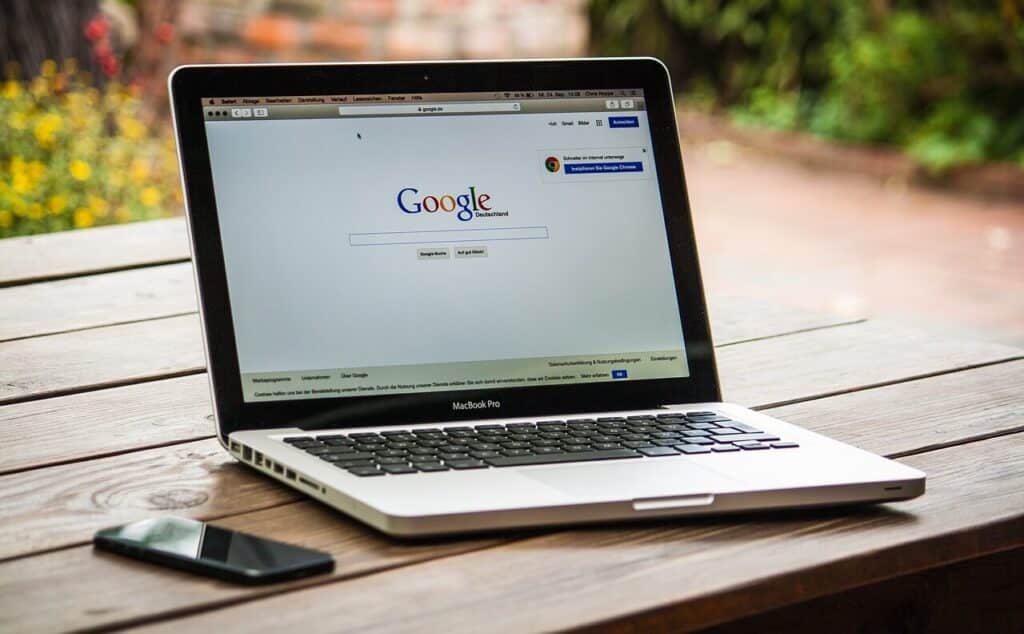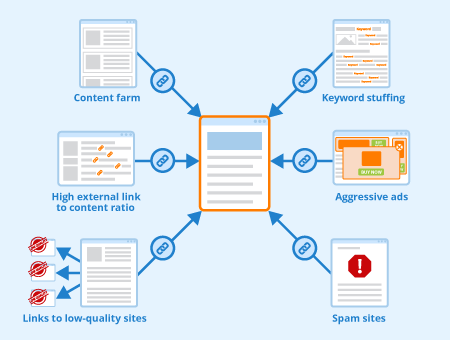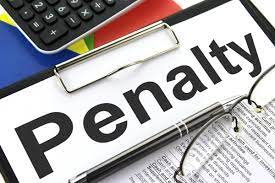
Key takeaways for you – Recovering from a Google Penalty
| – A Google penalty is a punishment given to websites violating Google’s guidelines. This can drop a site’s ranking or delist it completely. – Penalties can be algorithmic (automatic) or manual (human-reviewed). Algorithmic penalties may not mean you’re penalized, but rather, outranked by competitors. – Reasons for penalties include excessive reciprocal linking, unnatural links, low-quality or duplicate content, keyword stuffing, hidden links, unnatural outbound links, cloaking, and anchor text spam. – Identifying penalties requires checking Google Search Console (for manual actions) and assessing traffic data in Google Analytics for significant drops. – Recovering from penalties involves finding the cause and addressing the issue, whether it’s improving content quality, requesting the removal of spammy links, or disavowing harmful links. – It can take several months to recover from a Google penalty. Staying proactive by monitoring site stats and creating high-quality content can help avoid penalties in the first place. |
How did you feel when your parents grounded you for not listening to them?
I have no doubt that you were pretty upset.
You might have skipped school, didn’t do your homework, told them a lie, or tried to rebel by not listening to them. No matter the reason, your parents punished you for disciplining you.
Like your parents, Google punishes websites for maintaining a fair and high-quality online environment.
You might wonder why Google penalizes you and how to recover from that penalty.
To help you understand that, let’s first learn what a Google penalty is.
What is a Google penalty?
If Google suspects that a website has violated its guidelines and policies, it may issue a penalty.
In other words, the Google penalty is the punishment the search engine giant gives to your website when its content conflicts with the marketing practices enforced by Google.
When your site gets penalized, it means it is no longer listed on the SERPs, or your ranking for your targeted keyword has dropped drastically.
Google penalizes websites to maintain the quality of the results that come up for any query you type.
Obviously, the search engine giant wants to maintain a certain standard and doesn’t want to serve you with low-quality results. That’s EXACTLY the reason why Google is so relevant today.
It doesn’t want SEOs to bend its rules for the sole reason of ranking higher in the SERPS, and the Google penalty is the best way to stop that.
There are two types of Google actions – manual and algorithmic.
Algorithmic Action
An algorithmic penalty is an automated action that Google’s algorithm takes against your website for not following its guidelines. Algorithmic penalties can lower your website’s search ranking.
Google’s highly complex algorithm and crawlers work together to create search results.
Google crawlers move around the nook and cranny of the internet and collect data on your website, which is fed into the algorithm to rank it.
To calculate the ranking, Google’s algorithm uses many signals. Some positively affect your website, while others negatively impact it. Your website gets penalized for the latter.
But at the same time, you should remember that just because an algorithm update caused a rank or traffic drop on your website does not mean that your website has been penalized.
It may simply mean that you have been outranked or another website is doing better SEO than yours.
Now, understanding these kinds of situations is important for you because you may panic seeing this drop in your site’s ranking or traffic and try to fix something that is not broken and end up breaking something which is intact.
So whenever there is an algorithmic update, and you see a significant drop in ranking and traffic on your website, there is a good chance that your website has been AFFECTED.
I emphasize the word AFFECTED because it doesn’t mean your website is penalized.
With every algorithmic update, Google tweaks the algorithm in a certain way. When these tweaks happen, if your website does not meet its criteria, it will be affected by the update.
Interestingly, Google doesn’t even call them a penalty. They are just algorithmic actions and manual actions. To understand these two types of action, you need to understand how Google identifies spam.
The search engine giant identifies spam in different stages and tries to filter them out.
The definition of a spammy page may vary, but in simple terms, it is a page that does not offer any value to the users or help them in any manner.
Google has systems that can detect these pages at the crawling stage itself, and when it does so, these pages do not even reach the indexing stage.
In some cases, when a page passes through the crawling stage and gets indexed (it may not have added value as such, but it still has helped in some way), it is very unlikely that it would achieve a high ranking.
Google handles most of the spammy pages in the crawling and indexing stages.
But in some cases, websites have managed to rank higher by manipulating Google’s guidelines. To filter these types of spammy pages, Google uses manual action.
Manual Action
Manual action, as the name suggests, occurs manually. These penalties or actions occur when a human reviewer finds that your website violates Google’s Webmaster Quality Guidelines or tries to manipulate search results.
When Google takes a manual action, it removes your website or some of it from the search results.
You can check whether manual actions have been taken on your website by checking Google Search Console.
Now let’s move forward and find out why Google penalizes or takes action on websites.
What do you get Google Penalty for?

Here are some of the reasons why your website gets penalized:
Excessive reciprocal linking
Suppose a webmaster approaches you and asks you for a backlink and reciprocates it by giving you a backlink, it is called reciprocal linking.
Now, let’s say you use too many of these links in one of your content pieces, and they all point to a particular site. You may face a backlash if the same site links back to you in the same density.
Unnatural links
You shouldn’t be getting a backlink from an unrelated website or a website that doesn’t add any value to your content.
Precisely, the best way to get a backlink is to earn them. And that happens when you create a piece of content that is valuable and useful for your niche and industry.
When you create such content, other websites from your niche find your content useful and link to them.
On the other hand, unnatural links are links that are created to manipulate a webpage’s search engine ranking. Google penalizes your site for using them.
You can create relevant and useful content that other websites from your niche loves to link to stay away from unnatural links.
Low-quality or duplicate content
Actually, duplicate content does not lead to a Google penalty.
That said, if Google finds out that you are copypasting from other websites, it will go ahead and rank the website you are copypasting from.
So you will not rank for that keyword or content any which way,
This means you should avoid creating low-quality or duplicate content.
The golden era of 300-500 word articles is over now. You should now concentrate on creating well-researched in-depth content that helps your users.
At the same time, you need to assess whether a particular query needs a 3000-word or 200-word answer.
The only way to decide whether to write a 3000-word or 200-word article is to go to Google search and type your query. Now check the top articles and blogs that are ranking for that keyword and how they approach it.
Keyword Stuffing
Keyword stuffing is unnaturally forcing a particular keyword into a sentence. It can also be the keyword density or how often you have used a particular keyword in your content.
So when you are doing keyword research, you are doing it to structure your content in a certain way. You can prioritize primary, secondary, and LSI keywords as per their importance and create content around them.
But that does not mean you can impose these keywords and stuff them here and there without thinking about the quality of content you provide to your users.
Moreover, Google prefers NLP (Natural Language Processing) and is pretty advanced in detecting it. So, even if you use a particular keyword, you can blend it into a sentence naturally, and Google will detect it.
This means if you use the keyword “what is keyword stuffing,” you do not necessarily use the EXACT keyword in a sentence or the heading or subheadings.
Hidden Links
Hidden links have the same font color as the background of a website. Google can penalize your website for using a hidden link.
Unnatural outbound link penalty
According to columnist Tony Edward, you must monitor your site’s outbound links.
You may already know how bad it is for your website to have unnatural spammy or inbound backlinks. But unnatural outbound links can also get your website penalized.
These are also called bad neighborhood links, wherein you may be linked to other sites in exchange for money, service, or links. This may be a spammy website that can create a bad neighborhood for your own website.
Because of that, Google understands that the only reason you have given a backlink to this website is that it has paid money or exchanged a favor for this.
As a result, you may get a penalty.
Cloaking
Cloaking is like camouflaging in SEO. It is a black hat technique used by webmasters where different content is shown to Google and the website users to improve the website’s search engine ranking.
In short, you have two versions of the same page – one for users and one for Google bots.
Google considers it to be an offense and penalizes a site for it.
Anchor Text spam
Anchor text spamming is when you gain links with a specific anchor text in mind. It’s like almost all links to your website have the same anchor text.
In other words, when people link to you, they use the same anchor text all the time.
If you have 100 links pointing to your website and 97 have the same anchor text, Google considers them spammy and may penalize your site.
You can avoid this by having diversified anchor texts.
As you have learned about the causes of getting a Google penalty, let’s now move on to how to find out whether your site has got a penalty.
How to identify penalties?
You can check it in your search console when Google takes a manual action.
But If it is an algorithmic update, you need to wear your detective hat. At the same time, as I have already told you, do not panic and check whether there is an algorithmic update.
Wait for a week or two, as the core update needs some time to stabilize.
Start by checking your website’s stats in Google Analytics to see the date you lost your site’s traffic, and if there is an algorithmic update around that date, you are most likely hit by a penalty.
If you are penalized and your website gets affected, it could be likely because of your backlink profile.
You have come so far and have been enjoying good ranking and traffic, so in all probability, you do not have spammy content. The only thing that can go wrong at this stage is your backlink profile.
That’s why you need to check the following:
- Anchor text
Check if your anchor texts have diversity or not. To learn more about it, check out my blog.
- Spammy domains
The next thing you need to check is your website’s referring domains. And if these domains are really detrimental to your site’s health, you can disavow them using the Google tool.
You can also go ahead and try to build good links so that the ratio of good links overpowers the ratio of spammy ones.
Creating amazingly relevant content is the best way to get good backlinks. Additionally, Use informational keywords and reach out to high-quality blogs for guest posting.
How to recover from a penalty?

I have repeatedly mentioned that you need not panic if your website is penalized. Simply follow these two steps to recover from a Google penalty.
Step 1: Find the why
As I have already mentioned, you will be notified in your Google Search Console if it is a manual penalty.
But if it is an algorithmic one, check the date on which your site’s traffic dropped and also make sure there has been an algorithmic update around that time.
If it’s an algorithmic one, check your backlink profile.
Step 2: Address the issue
Depending on the problem, find a solution. You may have issues in the following areas, and you may need to do the following:
- Replacing duplicate content with original ones that really helps your users.
- Ask spammy domains to remove the links to your site
- Remove all hidden links
- Disvow any spammy links that can harm your website
- Create unique content that is trusted and loved by all to get organic backlinks.
How long does it take to recover from a Google penalty?
Recently, Google has answered this exact question during Google SEO office hours.
Hear it from the horse’s mouth.
“Well, it’s generally a good idea to clean up low-quality content or spammy content that you may have created in the past,
For algorithmic actions, it can take us several months to reevaluate your site again to determine that it’s no longer spammy.”
Google’s John Mueller also stated:
“I think it’s a lot trickier when it comes to things around quality in general where assessing the overall quality and relevance of a website is not very easy.
It takes a lot of time for us to understand how a website fits in with regards to the rest of the Internet.
…And that’s something that can easily take, I don’t know, a couple of months, a half a year, sometimes even longer than a half a year, for us to recognize significant changes in the site’s overall quality.
Because we essentially watch out for …how does this website fit in with the context of the overall web and that just takes a lot of time.”
Don’t panic, just learn how to recover and, if possible, avoid Google’s penalty
I would say the best policy is to avoid penalties before Google even starts crawling your website pages.
Keeping a tab on your website stats and monitoring it occasionally.
Avoiding a penalty may sound impossible to you but believe me, it is very much doable.
And that’s EXACTLY why it is important to create high-quality content that ACTUALLY helps your users.
FAQs
What is one step to take to recover from a Google penalty?
First of all, check whether an algorithmic update could have impacted the recent drop in traffic or ranking on your website.
Next, check your backlink profile and clear it if it has any spammy links.
What happens when you get a Google penalty?
Googler Aurora Morales says, “Sites that don’t meet the monetization and organic search guidelines may be removed from the Search index and have their ads disabled.”


